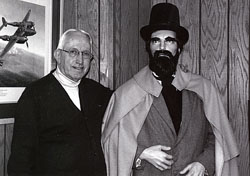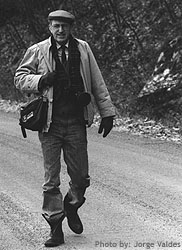 |
||||||
THE WEB PAGE AUTHOR
 |
"Colonel" Edwin Laurentine Drake (right) and the author, Samuel T. Pees, in my Meadville, Pennsylvania, office.1996 |
Certified Petroleum Geologist by The American Association of Petroleum Geologists (AAPG). Senior Fellow of Geological Society of America (GSA). Licensed Professional Geologist, Pennsylvania.
Worked as a petroleum geologist in South America, Central America, Caribbean, North America, South Pacific, S.E. Asia, Indonesia and Australia. Established the firm of Samuel T. Pees and Associates in Meadville, Pennsylvania, for oil and gas consulting in the Appalachian Basin and South America.
 |
From Vol. 1, Issue 1 of the OILFIELD BARKER, 1993 A publication of The Colonel Inc., Drake Well Museum At that time the author was President of The Colonel Inc., and this was the first of the President's Columns written for that publication. |
"My story starts in Oil Creek Valley. My father had a great interest in oil history and took me many times to the Drake Well in the mid-1930's and to other sites in the early oil belt. Living in Meadville, Pennsylvania, there were two approaches to the oil region. One was directly to Titusville on Route 27 and the other via Franklin on Route 322. I liked the latter best because the road went directly through an oil refinery, the Amalie Refinery, on the outskirts of Franklin. Tanks and towers were on both sides of the highway, and pipes snaked across it overhead. We always rolled the windows down so that we could better smell the crude oil and product. Maybe some people would object to the odor of oil, but to us it was one of the symbols of Pennsylvania. Clears the sinuses, invigorates the system, I was told.
As a youngster, my faith in the powers of Pennsylvania crude was further bolstered by a gentleman "hawker" who was to be seen on the grounds of the Drake Well selling little souvenir bottles of oil. He claimed that Drake's oil was a cure for baldness and "weakness of the hair". "Just rub it in", he said. Naturally he was living proof that this worked because he had a magnificent head of dark, wavy hair. This was his way of selling oil for the benefit of the fledgling museum. I still have my souvenir bottle, part full, and it bears the words Diamond Jubilee of Oil, Aug. 24-27, 1934, Titusville, Pa., printed in white on the glass.
Some years rolled by and I returned to Meadville on vacation after a rather long stint as a petroleum geologist in Venezuela and Peru. This was 1960, Dad was on a new kick, Pithole, but not the cellars of that old ghost town. He was interested in locating the burial plot of the Holmden family, homesteaders on Pithole Creek. No explanations given. Off we went through brush, crossing a multitude of above-ground pipelines until we found the plot with its iron grill fence in the woods down by Pithole Creek. Outside of the family burial place, I remember seeing unmarked depressions side by side through the woods, sometimes with a daffodil surviving. This must have been where some of the Pithole oil pioneers of 1865-66 ended up.
Later in the 1970's, Dad caught me again when I was visiting home after a spell abroad as an explorationist for oil companies. This time he was interested in a small and forgotten oil field in West Mead Township, Crawford County. This last surviving driller was a pal of Dad's. The old wells were still there, but most were impossibly hidden in the brush. This turned out to be a two-week enterprise culminating with the discovery of a tank that still had some of the local crude in it. Well, it's bottled now and in my office.
Between Dad and Dr. Paul Giddens (author of the BIRTH OF THE OIL INDUSTRY and first Curator of the Drake Well Museum), an oil historian whom we knew quite well, it can be said that I was shanghaied at an early date into the oil business. My only independent decision was to enter it as a petroleum geologist. There was another influence that I now suspect was part of Dad's grand plans. This was to make sure that I gave oil history its due. In the 60's when I happened to have a few days at home now and then, there was a certain book always conspicuous in a handy place like the coffee table or mantle. The moment I started reading it, I couldn't put it down. It was the first edition of TINTYPES IN OIL by Ernest C. Miller. Ernie certainly made the Valley come alive! That was the hook that caught the fish.
After searching for oil and other minerals for years around the globe, this writer is glad to be home. Every chance I get, I'm out in Oil Creek Valley looking for the remains of America's first oil boom in the first oil belt of the Appalachians."
| © 2004, Samuel T. Pees all rights reserved |
|